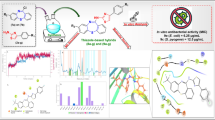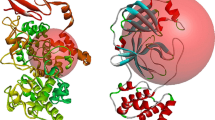Abstract
Dormant endospores of Bacillus anthracis are the causative agent of anthrax, which is an acute disease for both human and animals. Anthrax has been practised as biological weapon because of two attributes: i) short duration of spore germination, and ii) lethal toxaemia of the vegetative stage. Pathogenesis is caused by the activity of edema toxin and lethal toxin. Protective antigen (PA), is an essential component of both complexes, binds to Anthrax Toxin Receptor (ATR) and mediates the lethality in mammals. The combination of vaccine and antibiotics are preferred to be effective treatment for destruction of the vegetative cell wall but could not be a successive destructor for endospores. So the present study is intended to identify the small molecules as a potential inhibitor for ATR1. 3D structure of Anthrax Toxin Receptor 1 (ATR1) was built by using the crystal structure of Anthrax Toxin Receptor 2 (ATR2) from Homo sapiens as template. Molecular docking of 6-thiogunaosine (6-TG) analogs was performed on the ATR1 model and effective inhibitor was selected based on the docking results. The docking results showed that the three residues in the ATR1 binding pocket (Phe162, Asp160, and Phe22) were essential for making hydrogen bond with the 2-(2-bromo-6-chloro-4H-purin-9(5H)-yl)- 5-(hydroxymethyl) tetrahydrofuran-3,4-diol (C11H13N3O5). The data presented here strongly indicate that the interactions of these four residues are necessary for a stronger binding of the ATR1 with C11H13N3O5. Also, the study proposed C11H13N3O5 as an effective inhibitor by the comparison of docking energy.
Graphical abstract



Similar content being viewed by others
References
Abrami, L., Liu, S., Cosson, P., Leppla, S.H., Van der Goot, F.G. 2003. Anthrax toxin triggers endocytosis of its receptor via a lipid raft-mediated clathrindependent process. J Cell Biol 160, 321–328.
Altschul, S.F., Gish, W., Miller, W., Myers, E.W., Lipman, D.J. 1990. Basic local alignment search tool. J Mol Biol 215, 403–410.
Aparoy, P., Reddy, R.N., Guruprasad, L., Reddy, M.R., Reddana, P. 2008. Homology modelling of 5-lipooxygenase and hints for better inhibitor design. J Comput Aided Mol Des 22, 611–619.
Banks, D.J., Ward, S.C., Bradley, K.A. 2006. New insights into the functions of anthrax toxin. Expert Rev Mol Med 8, 1–18.
Bradley, K.A., Mogridge, J., Jonah, G., Rainey, A., Batty, S., Young, J.A. 2003. Binding of anthrax toxin to its receptor is similar to alpha integrin-ligand interactions. J Biol Chem 278, 49342–49347.
Brunger, A. 1992. X-PLOR, Version 3.1: A System for X-Ray Crystallography and NMR. Yale University, New Haven, CT.
Chenna, R., Sugawara, H., Koike, T., Lopez, R., Gibson, T.J., Higgins, D.G., Thompson, J.D. 2003. Multiple sequence alignment with the Clustal series of programs. Nucleic Acids Res 31, 3497–3500.
Diaz, A., Horjales, E., Rudino, P.E., Arrola, R., Hansberg, W. 2004. Unusual Cys-Tyr covalent bond in a large Cyp51A&B. J Mol Biol 342, 971–973.
Duesbery, N.S., Webb, C.P., Leppla, S.H., Gordon, V.M., Klimpel, K.R., Copeland, T.D., Ahn, N.G., Oskarsson, M.K., Fukasawa, K., Paull, K.D., Vande Woude, G.F. 1998. Proteolytic inactivation of MAPkinase by anthrax lethal factor. Sci 280, 734–737.
Feller, S.E., MacKerell, A.D.Jr. 2000. An Improved empirical potential energy function for molecular simulations of phospholipids. J Phys Chem B 104, 7510–7515.
Grubmuller, H., Heller, H., Windemuth, A., Schulten, K. 1991. Generalized Verlet algorithm for efficient molecular dynamics simulations with long-range interactions. Mol Simulat 6, 121–142.
Guex, N., Peitsch, M.C. 1997. SWISS-MODEL and the Swiss-PdbViewer: An environment for comparative protein modeling. Electrophoresis 18, 2714–2723.
James, M.M., John, E.D., John, H.C., Stephen, F.M. 2011. Protien-ligand interactions: Thermodynamics effects associated with increasing nonpolar surface area. JACS 133, 18515–18521.
Kale, L.R., Skeel, M., Bhandarkar, R., Brunner, A., Gursoy, N., Krawetz, J., Phillips, A., Shinozaki, K., Varadarajan, K., Schulten, K. 1999. NAMD2: Greater scalability for parallel molecular dynamics. J Comput Phys 151, 283–286.
Leppla, S.H. 1982. Anthrax toxin edema factor: A bacterial adenylate cyclase that increases cyclic AMP concentrations of eukaryotic cells. Proc Natl Acad Sci USA 79, 3162–3166.
Liu, H.H. 1999. Antibiotic resistance in bacteria: A current and future problem. Adv Exp Med Biol 455, 387–396.
Mackerell, A.D. Jr., Bashford, D., Bellott, M., Dunbrack, R.L. Jr., Evanseck, J.D., Field, M.J., Fischer, S., Gao, J., Guo, H., Ha, S., Joseph-McCarthy, D., Kuchnir, L., Kuczera, K., Lau, F.T.K., Mattos, C., Michnick, S., Ngo, T., Nguyen, D.T., Prodhom, B., Reiher, W.E., Roux, B., Schlenkrich, M., Smith, J.C., Stote, R., Straub, J.E., Watanabe, M., Wiokiewicz-Kuczera, J., Yin, D., Karplus, M. 1998. All hydrogen empricial potential for molecular modeling and dynamic was studies of protein using the CHARMM22 force field. J Phys Chem 281, 1630–1635.
MacKerell, A.D. Jr., Banavali, N., Foloppe, N. 2001. Development and current status of the CHARMM force field for nucleic acids. Biopolymers 56, 257–265.
Monique, A., Raynal, C.S., Adel, M.N., Ludmyl, A., Jurgen, B., Ernesto, A.S. 2007. Identification of an in vivo inhibitor of Bacillus anthracis spore germination. J Biol Chem 282, 12112–12118.
Purohit, R., Sethumadhavan, R. 2009. Structural basis for the resilience of darunavir (TMC114) resistance major flap mutation of HIV-1 protease. Interdiscip Sci Comput Life Sci 1, 320–328.
Ramamoorthy, M., Chinnaiah, S.V., Maruthamuthu, R., Ekambaram, R. 2008. A study of molecular modeling, dynamics and mechanics of cyp2b6 and nk binding using Hex. JCIB 1, 109–114.
Sali, A., Blundell, T.L. 1993. Comparative protein modelling by satisfaction of spatial restraints. J Mol Biol 234, 779–815.
Thompson, J.D., Higgins, D.G., Gibson, T.J. 1994. CLUSTAL W: Improving the sensitivity of progressive multiple sequence alignment through sequence weighting, position-specific gap penalties and weight matrix choice. Nucleic Acids Res 22, 4673–4680.
Van der Goot, F.G., Young, J.A. 2009. Receptors of anthrax toxin and cell entry. Mol Aspects Med 6, 406–412.
Vitale, G., Pelizzari, R., Recchi, C., Napolitani, G., Mock, M., Montecucco, C. 1998. Anthrax lethal factor cleaves the N-terminus of MAPKKs and induces tyrosine/threonine phosphorylation of MAPKs in cultured macrophages. Biochem Biophys Res Commun 248, 706–711.
Young, J.A., Collier, R. 2007. Anthrax toxin: receptor binding, internalization, pore formation, and translocation. Annu Rev Biochem 76, 243–265.
Author information
Authors and Affiliations
Corresponding author
Additional information
The authors contributed to the paper equally.
Electronic supplementary material
Electronic supplementary material
Rights and permissions
About this article
Cite this article
Singh, N.K., Pakkkianathan, B.C., Kumar, M. et al. Computational studies on molecular interactions of 6-thioguanosine analogs with anthrax toxin receptor 1. Interdiscip Sci Comput Life Sci 4, 183–189 (2012). https://doi.org/10.1007/s12539-012-0126-9
Received:
Revised:
Accepted:
Published:
Issue Date:
DOI: https://doi.org/10.1007/s12539-012-0126-9




